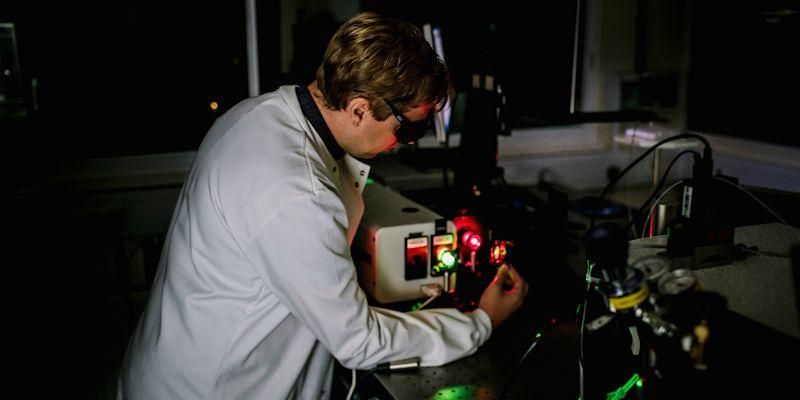
Current treatment for head and neck cancer can have debilitating side-effects, but new research combining robotics, nanoparticles, ultrasound and lasers could treat it without chemo- or radiotherapy.
Dr James McLaughlan, a University Academic Fellow in the faculties of Engineering and Medicine and Health, is leading the research programme.
He said a successful outcome to the work could reduce the need for traditional therapies. It would free up the large multidisciplinary teams of medical professionals needed to carry them out to support other patients or more complex cases.

Dr McLaughlan testing the laser alignment system.
Dr McLaughlan, who has received an EPSRC-UKRI Innovation Fellowship for his research, said: “Our study sets out to develop a new prototype treatment system that could improve diagnosis and therapy for head and neck cancers, whilst also significantly lowering costs within the NHS by reducing the need for highly-trained surgical teams.
“Uniquely, it combines nanoparticles targeted to cancer cells with laser illumination and ultrasound, and a waterproof robotic system that has been developed in conjunction with a UK manufacturer, ST Robotics.”
Using bubbles to target cancer cells
He said: “It’s possible to manufacture nanoscale metallic particles that attach to cancerous cells. Once they have attached, the treatment system is able to activate the particles by exposing them to simultaneous ultrasound and laser illumination, which causes bubbles to form around the nanoparticles.
“When the bubbles burst, they emit a clear ultrasound signal that can be detected using a standard ultrasound imaging system.”
This approach offers real-time visualisation of the cancerous areas, which can then be immediately treated by thermal ablation, a procedure that involves using heat to remove tissue.
High-intensity focused ultrasound (HIFU), a method already in clinical use for treating cancers such as liver and prostate, is used to achieve thermal ablation during the procedure.
“When the bubbles pop, I can pinpoint the cancer sites very accurately. Then, using the same system, I’m able to destroy the cancer.”
Dr McLaughlan continued: “When the bubbles pop, I can detect where they are. This allows me to pinpoint the cancer sites very accurately. Then, using the same system, I’m able to destroy the cancer, essentially cooking it with thermal ablation using HIFU, which is enhanced by the presence of those bubbles.

Developing the functionality of the robotic arm.
“The third part to this approach is incorporating the robotic system. This allows automation of the scanning and ablation.
“The waterproof robotic arm will enable semi-autonomous treatment of head and neck cancer. This apparatus is submerged in a water tank to allow patients to comfortably lie on a treatment bed with a small opening to allow for contact with the water.
“Having the system submerged in the water allows the imaging/therapy system to move around the area of interest in the patient without any direct physical contact.
“The ultimate idea is that instead of a complicated procedure requiring lots of medical professionals, it could be done by a single person monitoring the procedure. This would only be possible due to the unique combination of targeted nanoparticles, light, sound and robotics.”
Business partnerships
Dr McLaughlan’s fellowship, entitled ‘Semi-autonomous non-invasive surgery: The ‘outside in’ of molecular-targeted theranostics for cancer’ has a specific focus on innovation, and includes partnerships with two businesses:
- iThera Medical - a medical imaging company, which will help validation of the targeting of the particles using its pre-clinical imaging system.
- ST Robotics - which has developed a low-cost robotic arm being testing as part of the research. A key focus of this work is to translate it into eventual clinical use in 10-15 years.
Interdisciplinary research
Backing Dr McLaughlan’s work, Dr Maggie Wilson, Joint Head of Building Leadership at the Engineering and Physical Sciences Research Council, said his proposal brought together a multi-disciplinary team, and bridged two of the council’s priority areas, leading-edge healthcare and medicines, and robotics and artificial intelligence systems.
“ A good example of how engineering and technology can be utilised to improve healthcare”
Dr Wilson said: “The research is a good example of how engineering and technology can be utilised to improve healthcare provision, brings together industry and academia and will improve the supply of skilled researchers needed to build on the UK’s existing strengths and translate exciting discoveries and research through to commercial success and long-term benefits for the entire country.”
The fellowship was one of 74 awards from the recent EPSRC-UK Research and Innovation Fellowships call.
The University’s Nexus centre, due to open later this year, will provide a seamless way for business and industry to work with the University, giving access to its world-leading researchers, technology and facilities.
Further information
Article author: Clare Robertson.
Journalists with interview requests or who would like more information should contact Peter Le Riche in the University of Leeds press office on 0113 343 2049 or email p.leriche@leeds.ac.uk